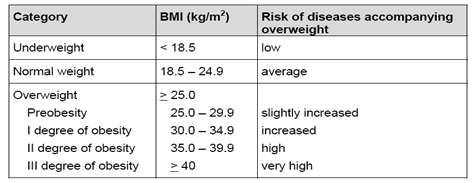BMI is a basic index of weight-to-height commonly used to classify underweight, overweight, and obesity in adults. The definition of "normal range" differs according to gender, age, and ethnicity, as different populations may have different associations between BMI and health risks.
Though BMI does not actually measure body fat, it is often used to estimate if a person is at risk for obesity-related diseases. Due to its ease of measurement and calculation, it is the most widely used diagnostic tool to identify weight problems within a population. The chart below is the classification of weight for adults over 18 years on the basis of Body Mass Index according to WHO, 2000 EK IV and WHO 2004 (WHO - World Health Organization).

Note: BMI is calculated purely based height on weight, and does not distinguish between muscle and fat. As such, it can be potentially misleading, particularly for individuals with higher levels of muscle mass.

